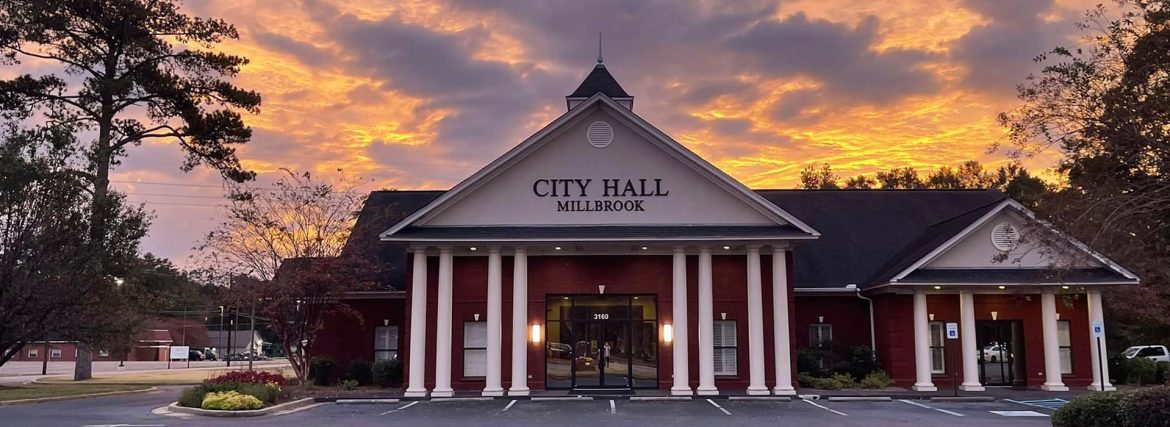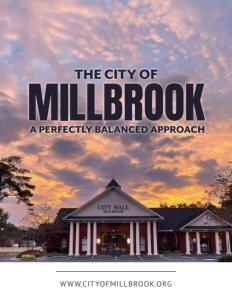A Perfectly Balanced Approach
How a bedroom community north of Alabama’s capital is crafting its own identity through strategic development while refusing to surrender its small-town charm.
Situated just 10 miles north of Montgomery, Millbrook has transformed from a quiet summer retreat for wealthy capital city residents into one of central Alabama’s fastest-growing communities. With a population approaching 17,000, this bedroom community is simultaneously embracing expansion while fiercely protecting its small-town identity.
“We are definitely in a growth mode, both in population and functionality, economic expansion,” says Ann Harper, Economic Development Director for the City of Millbrook. “We’re doing all sorts of improvements in infrastructure, amenities and overall quality of life. One of the things we are working on is balancing our growth with preserving our community character and what we call our small-town charm.”
The city’s strategy emphasizes family-oriented amenities, particularly its municipal park system. The crown jewel among its six public parks is the Village Green, which serves as the community’s primary gathering spot for festivals and events. In recent years, the city created a new position – Cultural Arts and Special Events Director – to cultivate programming that brings residents together in these spaces.
“Millbrook is a bedroom community without a doubt, and we don’t mind saying that,” notes Michael Gay, President of the City Council. “We strive very hard to maintain quality of life here. Montgomery is our major city, and we have many military people, civil service, and State of Alabama workers that make the short commute, which is less than 10 minutes. We try to keep a very good quality of life for our residents, taking pride in our parks and recreation.”
Creating a Vibrant Downtown
Unlike many historic Alabama communities that evolved around established town squares, Millbrook faces the unique challenge of designing its downtown core from the ground up. The city’s formation along the intersection of two state highways has shaped its development approach.
“Downtown is the next focus area for the city,” explains Gay. “We have been working on planning and building a downtown. In the meantime, we have improved the Village Green Park, upgraded our customized playground, and built a new park called Minnie Massey Park. Our city hall is now a focal point across the street from the Village Green Park. Down the street is our economic development center, which at one time served as City Hall. We have repurposed the building and now it serves as our home base to promote business and community growth.”
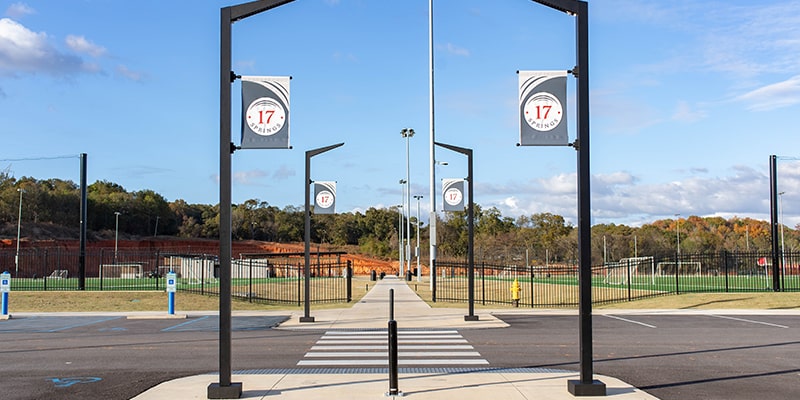
Millbrook’s downtown strategy focuses on creating a pedestrian-friendly environment that draws residents and visitors. This approach aligns with contemporary urban planning principles that prioritize walkability over vehicular access, encouraging community interaction and local economic activity.
“We don’t have the traditional downtown that some older cities have,” Harper explains. “We took the heart of the city, which is what we’re calling our downtown, and we’re crafting it really from the ground up. We’re trying to attract business while maintaining this beautiful Village Green Park where the community meets for all different festivals.”
The downtown vision emphasizes creating opportunities for local entrepreneurs rather than national chains, which are directed toward the Highway 14 corridor. This dual-track development approach allows Millbrook to cultivate its unique local identity while still attracting larger commercial interests.
“Your downtown, given the property and development, is going to create an environment easier for our entrepreneurs in the local community to come and open up businesses,” says Gay. “I’d love to see a bed and breakfast be part of that if they’re looking for some type of place for people to stay.”
Highway 14 Corridor
While Millbrook’s downtown development focuses on local businesses and community character, the Highway 14 corridor serves as the city’s commercial backbone. This five-lane thoroughfare, with its high traffic counts and visibility, has become the strategic focus for attracting national retailers, restaurants, and hotels to bolster the city’s economic base.
“The downtown reflects more of the local culture, the local brand, the mom-and-pop businesses,” Harper notes. “Highway 14, which is our main commercial corridor going through our city, is going to attract the national chains, the hotels, the people that require really large traffic counts and visibility. Not to say that we don’t have a good traffic count going through our downtown, it’s just not as high as it would be on Highway 14.”
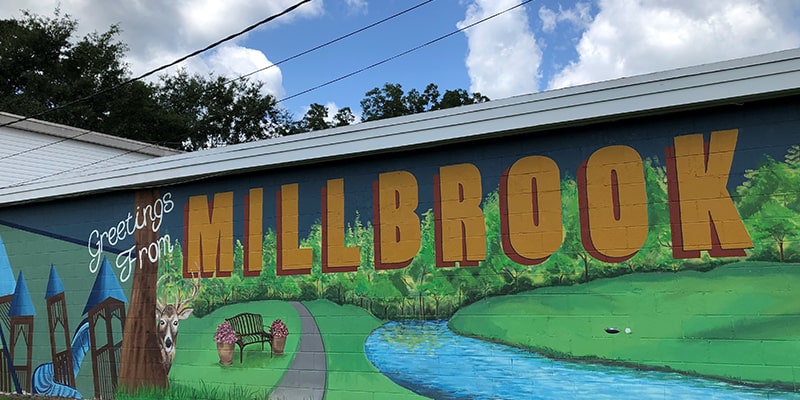
The city’s strategic position – with three Interstate 65 exits (176, 179, and 181) provides exceptional accessibility for commercial development. This infrastructure advantage has made Millbrook particularly attractive for businesses seeking locations with regional draw potential.
“We’ve got the Highway 14 corridor where your hotels tend to be more centered closer to your interstate,” explains Gay. “That’s why we have several undeveloped areas on our Highway 14 and college corridor to I-65. We’re attracting hotels and other developments there.”
This commercial corridor is undergoing significant expansion, with a major Highway 14 improvement project planned for 2026. Stuart Peters, Project Manager, City of Millbrook, who oversees infrastructure development, emphasizes the importance of staying ahead of growth-related challenges.
“We’ve got a very large and significant expansion of Highway 14, which is the gateway into Elmore County and goes right into Millbrook, that we’re working with the Alabama Department of Transportation on,” Peters says. “We’re trying to get ahead of all this increased traffic that we’re having. We’re also looking at existing intersections and future signaled intersections to control the traffic along our Highway 14 corridor.”
Building the Foundation for Growth
As Millbrook’s population approaches 18,000, making it the largest city in Elmore County, infrastructure investments have become critical to sustaining growth while maintaining quality of life.
“Infrastructure is the first critical component,” Peters explains. “Anytime you’ve got a high growth area north of the river, north of Montgomery, which Millbrook certainly is, you have to be proactive in all infrastructure areas. An example – high-speed fiber access and expansion throughout the city. The Internet is just as critical as any other utility. It’s expected just as much as sewer and water. These are all key components of strategic economic development.”
The city is taking a forward-thinking approach to wastewater management through innovative partnerships. Millbrook has joined with five other municipal partners on the Elmore County Unified Sewer Line, creating flexibility and cost-sharing opportunities that will serve the community for generations.
“We have captured back capacity from our sewer system, which buys us more time,” Gay notes. “Then we have the project with our partners that guarantees our future up to a certain number of years. It also places on the table partners that can help us share in the cost if we ever need to build a new sewer plant. From Millbrook’s future standpoint, 10, 20, 30 years out, the foundations have been laid to handle our sewer capacities multi-generationally.”
On the housing front, Millbrook is experiencing robust growth across price points. The market remains particularly strong, with homes selling within an average of 36 days, significantly faster than many comparable communities.
“There’s a huge need for entry-level homes, but there’s also a huge need for our higher-end homes,” Peters says. “We have a lot of transplants coming from the Montgomery area. We’ve got significant subdivisions such as Plantation Oaks and Camdens Cove right in the center of Millbrook. We’re seeing some regional builders coming into Millbrook, and we also have a couple of national builders tackling both entry-level and higher-end homes.”
Boosting Tourism and Economic Development
The 17 Springs development represents Millbrook’s most ambitious economic catalyst project, a 130-acre multi-use complex that combines recreational facilities, event venues, and commercial opportunities. This landmark public-private partnership unites five entities: the City of Millbrook, Elmore County Commission, Elmore County Board of Education, Montgomery area YMCA, and Elmore County Economic Development Authority.
“17 Springs is our catalyst project for commercial expansion in Millbrook,” Harper explains. “The sports facilities are essentially done and we’re going and blowing with them. We’re booking not only sporting events but non-sporting events because the field house is an 86,000 square foot indoor facility that can host indoor sports as well as concerts, trade shows, and things of that nature.”
Named after a historic Millbrook art festival once held at the YMCA property, the complex features twelve pickleball courts, twelve tennis courts, four multipurpose turf fields, and a fieldhouse phase with six diamond fields and a stadium. The facility has already attracted collegiate tournaments, youth basketball events, and baseball competitions, establishing Millbrook as a regional sports tourism destination.
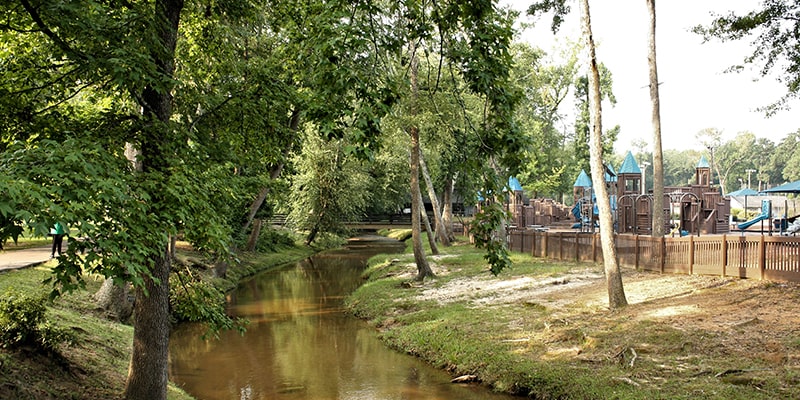
“You have to have a hook, a destination, and then from there people look for things to do,” Gay notes. “The 17 Springs hook is not only sports tourism but event tourism too. We have several expo shows scheduled soon, dinners out there, and you can have concerts. The whole facility in a sense is 12 months, 24/7 driving people in.”
The 18-acre commercial component, called “The Marketplace at 17 Springs,” fronts Highway 14 and has been divided into 12 parcels ranging from just under an acre to two and a half acres. The city recently announced its first flagship restaurant tenant, Baumhower’s Victory Grille, an Alabama sports-themed chain.
“We are looking for dining and lodging primarily to fill that development,” Harper says. “While people are there for their tournaments or concerts utilizing the sports facility, we want them to be able to have a place to eat and stay in our community overnight, not go outside or necessarily go home.”
Community Partnerships and Future Vision
Millbrook’s growth trajectory hinges on strategic partnerships that extend beyond city limits. The city has fostered collaborative relationships with educational institutions, county government, and economic development organizations to maximize impact while sharing resources and expertise.
“The Elmore County Commission is key to our growth and to helping us make things happen,” Harper says. “Being a smaller city, we can’t always do things on our own. We have a very good relationship with our country-governing body. They have a program where they’re putting what they’re calling quality of life projects all over the county. 17 Springs is one of those quality of life projects that they have helped us with tremendously in terms of not only funding parts of it but providing in-kind services and other types of support.”
Education represents another critical partnership area. While Millbrook doesn’t operate its own school system, it maintains close ties with the countywide educational infrastructure that serves its growing population of families.
“Our schools are under a countywide school system. Our relationship is very good with the individual schools, the principals and the leadership,” Harper explains. “Our high school is the largest high school in the county, which just shows people are coming in. Schools are very important because these kids are our future. Our challenge is we want these kids to get educated and stay here.”
Looking ahead to the next two years, city leadership has identified clear priorities centered on completing major development initiatives while preserving community character.
“In two years, certainly 17 Springs and the Marketplace will be complete. I would like to see a lot of momentum in the downtown area, and I think that’s on the horizon,” Peters says. “The Highway 14 corridor is going to continue to expand. I want to see these partnerships we have now continue to grow and blossom. I just see growth in all directions for Millbrook, while balancing that with trying to keep that small-town feel for the native people but also welcoming others who want this kind of lifestyle.”
AT A GLANCE
Who: City of Millbrook
What: Rapidly growing bedroom community transforming into a regional economic center
Where: Alabama
Website: www.cityofmillbrook.org
PREFERRED VENDORS/PARTNERS

Boostr Digital Displays is a leading Alabama based LED company specializing in high-quality indoor and outdoor video boards, scoreboards, and scorers tables. Serving schools, universities, churches, and businesses, Boostr delivers top-tier service and dependable products at an affordable price—helping every customer maximize impact without compromising on quality.
Boostr Digital Displays: www.boostrdisplays.com

Central Alabama Electric Cooperative (an electric utility) and its broadband subsidiary, Central Access, work together to fulfil the power and internet service needs of over 45,000 members in a 10-county service area in central Alabama. Formed in 1939, the cooperative is dedicated to enhancing the lives of those they serve.
Central Alabama Electric Cooperative: www.caec.coop

Stone Building Company has been in business for four decades as a premier general contractor serving the Southeast. Stone has successfully completed projects for a wide variety of clients in the institutional, healthcare, recreational, commercial, sports facility, civic, multifamily, and industrial market sectors. We believe that “Quality Work Builds Lasting Relationships.” It is this philosophy that keeps past clients contacting Stone for their future projects.
Stone Building Company: www.stonebuilding.com
